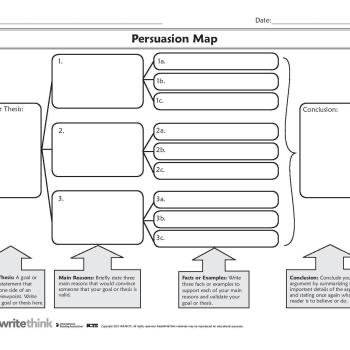Persuasion Map

About this printout
Use this graphic organizer to develop a persuasive stance for an essay, speech, poster, or any type of assignment that incorporates persuasion.
Teaching with this printout
Examples of persuasion surround our lives, and the ability to persuade others is a powerful asset. We can persuade people to act in our favor, help them to see our point of view, and sway their opinion to that of our own. The power of persuasion is far reaching, and it is a technique that students will use throughout their lives. This tool helps students formulate ideas for a persuasive argument by helping them determine their goal or thesis, identify three reasons to support it (with three facts or examples to support each reason), and restate the thesis in a conclusion statement.
Before your students use this tool independently, model its use for them. Choose a simple topic (such as, “Sixth Grade is the Best Grade” or “Why Our Lunch Period Should be Longer”). Then, fill in the Persuasion Map while discussing the process aloud, displaying the tool so that all students can see it.
Review students’ completed maps prior to having them continue with the persuasion assignment. This will provide you with an opportunity to check students’ understanding of persuasion and help those who need extra instruction.
More ideas to try
- Have students analyze a persuasive piece (for example, an advertisement or editorial in a newspaper or magazine) by filling in the map and discussing the authors’ strategies of persuasion.
- Encourage older students to create propaganda-based assignments by having them incorporate deceptive language in some of the “reasons” or “examples” on their maps. (Propaganda is a form of persuasion that uses deceptive language to exaggerate, distort, or conceal information.) Upon completion, have students read their maps orally and/or display them for their peers. Have students identify the deceptive language in their peers’ maps to create a class list of the examples used. As an additional follow-up, students can view and read advertisements, newspaper editorials, and other text that contain propaganda to search for use of the examples on the class list and to add additional ones.
- Have students complete two maps based on the same goal but with two different targeted audiences in mind. Attention to audience is an essential element of effective persuasion. For example, students might create maps to market a particular children’s toy; one map could target children as the audience, and the other could focus on parents as the audience. After they have completed their maps, have students read them to the class without identifying the intended audience. Ask the rest of the class to determine the intended audience and identify the specific clues that prompted their deductions. Finally, as a class, compare and contrast the language and words used for each intended audience.